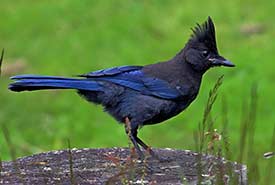
Steller's jay (Photo by chowan, iNaturalist)
Steller's jay (carlottae subspecies)
Steller’s jay is the provincial bird of British Columbia. It is named after Georg Steller, a Russian naturalist who first described it in 1741, near Cordova, Alaska. A generalist forager, this species eats seeds, nuts, insects, berries and even small animals, eggs and nestlings. It also uses backyard feeders, eating peanuts, sunflower seeds and suet.
This species is bold, inquisitive and noisy.
There are two subspecies of BC’s provincial bird that can be found in Canada. The carlottae subspecies can only be found on Haida Gwaii.
What does the Steller's jay look like?
The Pacific Steller’s jay is a large songbird with a long beak, a prominent triangular crest on its head, broad, rounded wings and a long tail. Its head is charcoal grey, with inconspicuous white markings above the eyes. Its body is blue and the colour is lightest on its wings.
The Steller’s jay, carlottae subspecies, is found only on Haida Gwaii, where many endemic species occur, because of its isolation and ice-free areas that remained during the last glaciation period. Sometimes called Pacific Steller’s jay, this subspecies is larger and darker than the Steller’s jay found throughout western North America. Even within Haida Gwaii, there is variation in its appearance.
Where does the Steller's jay live?
The Steller's jay (carlottae subspecies) can only be found on Haida Gwaii.
What is the conservation status of the Steller's jay?
The carlottae subspecies has not been assessed by the Committee on the Status of Endangered Wildlife in Canada yet. It is assessed as vulnerable by NatureServe.
What is NCC doing to protect the habitat for the Steller's jay?
The Nature Conservancy of Canada protects Kumdis River Conservation Area where Steller’s jay can be found.





